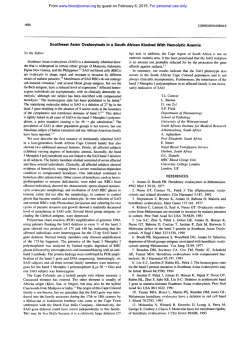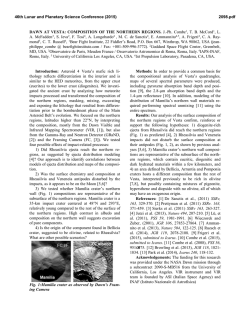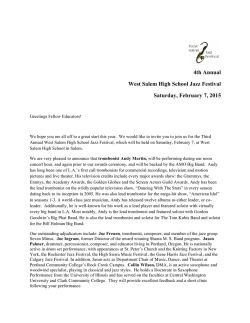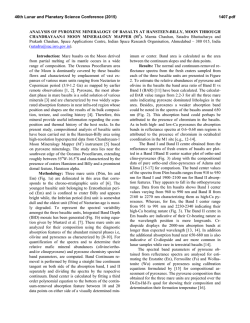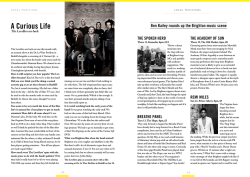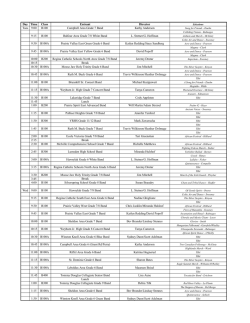
Blood 93/6
From www.bloodjournal.org by guest on February 6, 2015. For personal use only. CORRESPONDENCE 2131 Hereditary Spherocytosis Due to a Novel Frameshift Mutation in AE1 Cytoplasmic COOH Terminal Tail: Band 3 Vesuvio To the Editor: Band 3 (anion exchanger 1, AE1) is the most abundant integral protein of the red blood cell membrane. It is composed of 911 amino acids encoded by the EPB3 gene. Several mutations in the EPB3 gene have been found associated to different diseases, eg, hereditary spherocytosis, Southeast Asian ovalocytosis, chorea-acanthocytosis, and familial distal renal tubular acidosis, thus demonstrating that the effects of EPB3 mutation are dependent on type and location.1,2 The function of the band 3 carboxyl terminus tail that protrudes on the cytoplasmic side of the erythrocyte membrane is unknown.3 We describe the first example of a disease-causing mutation located in the extreme 3Ј end of the AE1 coding sequence. Hereditary spherocytosis (HS) is a common hemolytic anemia in which the spheroidal, osmotically fragile erythrocytes are destroyed in the spleen. HS due to band 3 deficiency has an autosomal dominant mode of transmission and is characterized by mild to moderate anemia.1 Six children, belonging to unrelated Italian families from the Vesuvian area (Southern Italy), presented a homogeneous clinical picture showing moderate hemolytic anemia and splenomegaly. HS was diagnosed on the basis of clinical findings, familial history, and routine hematological investigations. The protein phenotype, performed by sodium dodecyl sulfate-polyacrylamide gel electrophoresis (SDSPAGE), was typically that of band 3-deficient HS (band 3/spectrin: Fig 1. Heteroduplex analysis of exon 20 of band 3 genomic DNA. In all 11 HS patients, heteroduplexes were visible (they were generated on PCR between normal fragments and fragments carrying the C deletion). *Band shows heteroduplex produced by silent polymorphism occurring in trans. Ϫ21% Ϯ 2% compared with that of the controls).4 In all patients, single/strand conformation polymorphism (SSCP) screening of band 3 gene showed an alteration in exon 20 (not shown).4 Direct sequencing of the abnormal fragments constantly showed a deletional frameshift mutation in codon 894 (ACC = AC; not shown). We designated this mutation with the area of origin as Vesuvio. Heteroduplex analysis confirmed this mutation in 5 additional patients in the 6 families. This analysis failed to find the mutation in 4 healthy members (Fig 1). In 2 brothers of family 3 we also detected a previously described silent polymorphism (codon 904, TAC = TAT)5 occurring in trans (Fig 1 and not shown). Analysis of the PstI polymorphic site of the EPB3 gene indicated that HS was invariably associated with a PstI (ϩ) allele (not shown). Semiquantitative reverse transcription-polymerase chain reaction (RT-PCR) amplification with primers flanking the deletion (primer sense in exon 19 and primer antisense in exon 20) and with lower numbers of cycles produced heteroduplexes, suggesting that mRNA corresponding to allele Vesuvio was expressed (Fig 2). Urinary pH and acid excretion were in the normal range in all patients. Band 3 Vesuvio is the first mutation located in the cytoplasmic COOH terminal tail. The singularity of this mutation is the opening of the reading frame for an extra 133 codons (instead of 18), before the new stop codon at position 1027. The presence of the corresponding mRNA suggests that neither the transcription of the mutant gene nor the From www.bloodjournal.org by guest on February 6, 2015. For personal use only. 2132 CORRESPONDENCE Fig 2. Mutant band 3 mRNA is detected in patient II1 of family 1. The presence of the cDNA Vesuvio was verified by PCR amplification of reverse-transcribed total reticulocyte RNA. Aliquots of the PCR reaction after 14, 16, 18, and 20 cycles were screened using heteroduplex analysis. stability of the mutant mRNA is affected. Nevertheless, because no elongated additional band 3 was seen by Western blotting (not shown), we offer one of the following possibilities to explain the band 3 deficiency: (1) abnormal band 3 insertion in the endoplasmic reticulum; (2) defective translocation of mutant band 3 from the endoplasmic reticulum to the plasma membrane; and (3) premature band 3 degradation in the bone marrow erythroblasts. The COOH-terminal 18 amino acids of the normal band 3 are predicted to be replaced by an abnormal sequence in band 3 Vesuvio. Alignment of the 13 known sequences pertaining to different members of the three anion exchanger families (AE1, AE2, and AE3) shows that the amino acids in positions 897, 901, 905, and 906 are highly conserved through evolution. As reported by Anderson and von Heijne,6 these affected residues could act as stop transfer signals during cotranslational insertion of band 3 protein into the endoplasmic reticulum membrane of erythroid precursor cells. Furthermore, alternatively and/or additionally, the presence of a much longer COOH terminus could be the hindrance to the band 3 insertion. Band 3 Vesuvio mutation shows that the cytoplasmic COOH terminal tail is also very critical for the assembly and/or maintaining of band 3 in the mature erythrocyte membrane. Finally, we did not evaluate the unlikely possibility of a mutant band 3 insertion into the plasma with proteolytically truncation to a size similar to normal band 3. We found band 3 Vesuvio in 6 unrelated families from the same geographic area. Because this mutation is located on the same Pst1 allele and does not occur in a hot spot area, the presence of a founder effect is strongly suspected. Silverio Perrotta Raffaella Polito Maria Luisa Conte Bruno Nobili Stefano Cutillo Emanuele Miraglia del Giudice Dipartimento di Pediatria Seconda Universita` degli Studi di Napoli Napoli, Italy Vincenzo Nigro Istituto di Patologia Generali ed Oncologia Seconda Universita` degli Studi di Napoli Napoli, Italy Achille Iolascon Dipartimento di Biomedicina dell’Eta` Evolutiva Universita` di Bari Bari, Italy Giovanni Amendola Dipartimento di Pediatria Ospedale San Leonardo Castellammare di Stabia Italy REFERENCES 1. Gallagher PG, Forget BG, Lux SE: Disorders of the erythrocyte membrane, in Nathan DG, Orkin SH (eds): Nathan and Oski’s Hematology of Infancy and Childhood, vol 1. Philadelphia, PA, Saunders, 1998, p 544 2. Bruce LJ, Cope DL, Jones GK, Schofield AE, Burley M, Povey S, Unwin RJ, Wrong O, Tanner MJA: Familial distal renal tubular acidosis is associated with mutations in the red cell anion exchanger (Band 3, AE1) gene. J Clin Invest 100:1693, 1997 3. Lieberman DM, Reithmeier RAF: Localization of the carboxyl terminus of band 3 to the cytoplasmic side of the erythrocyte membrane using antibodies raised against a synthetic peptide. J Biol Chem 263:10022, 1988 4. Miraglia del Giudice E, Vallier A, Maillet P, Perrotta S, Cutillo S, Iolascon A, Tanner MJA, Delaunay J, Alloisio N: Novel band 3 variants (bands Foggia, Napoli I and Napoli II) associated with hereditary spherocytosis and band 3 deficiency: Status of the D38A polymorphism within the EPB3 locus. Br J Haematol 96:70, 1997 5. Eber SW, Gonzales JM, Lux ML, Scarpa AL, Tse WT, Dornwell M, Herbers J, Kugler W, Ozcan R, Pekrun A, Gallagher PG, Schroter W, Forget BG, Lux SE: Ankyrin-1 mutations are a major cause of dominant and recessive hereditary spherocytosis. Nat Genet 13:214, 1996 6. Anderson H, von Heijne G: A 30-residue-long ‘‘export initiation domain’’ adjacent to the signal sequence is critical for protein translocation across the inner membrane of Escherichia coli. Proc Natl Acad Sci USA 88:9751, 1991 Splenectomy in Agnogenic Myeloid Metaplasia To the Editor: Agnogenic myeloid metaplasia (AMM) is a clonal myeloproliferative disorder characterized by progressive bone marrow fibrosis and extramedullary hematopoiesis.1 Because of the lack of curative options, treatment is mostly palliative and is essentially aimed at improving severe cytopenia and at relieving symptomatic organomegaly.2 In a substantial number of patients this can only be achieved with splenectomy.3 It was therefore with the greatest interest that we read the report by Barosi et al4 reporting the association of splenectomy with a higher than expected incidence of acute leukemic transformation in patients with AMM. Although the observations and the conclusions reported in the study are interesting, we believe that alternative explanations should also be considered. This has important clinical implications, because the hypothesis proposed by Barosi et From www.bloodjournal.org by guest on February 6, 2015. For personal use only. 1999 93: 2131-2132 Hereditary Spherocytosis Due to a Novel Frameshift Mutation in AE1 Cytoplasmic COOH Terminal Tail: Band 3 Vesuvio Silverio Perrotta, Raffaella Polito, Maria Luisa Conte, Bruno Nobili, Stefano Cutillo, Emanuele Miraglia del Giudice, Vincenzo Nigro, Achille Iolascon and Giovanni Amendola Updated information and services can be found at: http://www.bloodjournal.org/content/93/6/2131.full.html Articles on similar topics can be found in the following Blood collections Information about reproducing this article in parts or in its entirety may be found online at: http://www.bloodjournal.org/site/misc/rights.xhtml#repub_requests Information about ordering reprints may be found online at: http://www.bloodjournal.org/site/misc/rights.xhtml#reprints Information about subscriptions and ASH membership may be found online at: http://www.bloodjournal.org/site/subscriptions/index.xhtml Blood (print ISSN 0006-4971, online ISSN 1528-0020), is published weekly by the American Society of Hematology, 2021 L St, NW, Suite 900, Washington DC 20036. Copyright 2011 by The American Society of Hematology; all rights reserved.
© Copyright 2025



